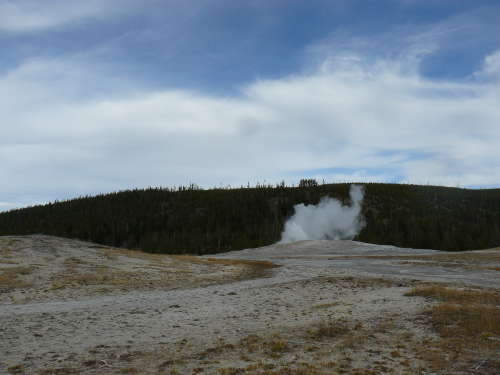 Location Taken: Yellowstone National Park, Wyoming
Location Taken: Yellowstone National Park, Wyoming
Time Taken: October 2012
Poor Old Faithful. It’s just not what it used to be.
It used to give a show nearly every hour on the hour. Well, ok, not quite, but it did have an average time between eruptions of 65 minutes. Geysers are rarely exact to the minute, mind you. There’s a lot of variation in even the most dependable examples of their kind. Which was a group that included Old Faithful.
But then came the earthquake. The Hebgen Lake earthquake of 1959 to be exact. It struck the northwest corner of the Yellowstone region, right near where Idaho, Wyoming, and Montana all meet. There’s a lovely lake there, and it was a beautiful August night, the height of tourist season. Hundreds of campers were snoring away in the campgrounds lining the Madison River that flowed out of Hebgen Lake.
And then, the world shook.
The earthquake itself wasn’t so bad. Earthquakes, in and of themselves, are not that deadly. It’s the things that get shaken that cause the real problem. All those massive death tolls you hear of come from either houses falling on people (which at least these campers had no worries about) or from sections of earth or water getting shaken too much. If your house is strong, and if you’re not in an area threatened by landslides or tsunamis, you will come out just fine. Well, assuming you didn’t store a bowling ball on a top shelf and were standing in the wrong spot at the wrong time. There’s no accounting for bad judgement or luck.
The main landslide caused that night fell down the slopes around the Madison river, just south of the main campsite. The slide caught a few people by complete surprise. A very brief surprise. It also caused an air blast strong enough to pick up grown men. That’s not hyperbole, by the way. One Mrs. Bennett saw her husband clinging on to a tree for dear life, waving like a flag- and then he was gone. She became a widow that night, and lost four of her five children.
If the slide and the air blast weren’t enough, the fallen rock completely blocked the narrow canyon and dammed up the river. The water levels quickly rose, and all the survivors had to desperately scramble up the slopes to avoid drowning. Not all of them managed that. In total, 28 people died from the event. Nineteen of those were never found at all. Their bodies probably lie under the slide that sealed their fates.
The slide itself formed another lake, called (creatively enough) Earthquake Lake. And life soon returned to normal, for all except the families of the victims.
And except for the geysers.
Geysers are formed by water super-heated by volcanic heat, forced through what’s essentially a natural pressure cooker. Unlike hot springs, geysers are quiet most of the time as the water and steam gathers in a complex maze of underground chambers, and then, through a glorious cascade effect, pressure empties the reservoir in one marvelous display. And then it sits quietly, refills, and waits for the next trigger moment.
Any change to the complex internal structures of a geyser will have major effects on how it performs. Closing off a chamber, opening one up, or creating a new route to the surface- all these are rather easy to do with minor shifting of the earth. And the Hebgen Lake Earthquake was no minor shifting. Many of the geysers throughout Yellowstone erupted right after the earthquake, with no care for their regular schedules. Several of them shifted their established patterns. One of them even started erupting continuously, becoming less of a geyser and more of a hot spring.
And Old Faithful, well, became less faithful. And yet, more predictable.
Gone are the days of shows every 65 minutes. Well, sometimes. It still does have a 65 minute interval. It just also occasionally shifts to a 91 minute break. It’s also fairly easy to tell which it will be. If the eruption lasted less than 2.5 minutes, the next show will be in 65 minutes, and if more than that 2.5, it’ll be in 91 minutes. With a margin of error of 10 minutes, of course. Nature abhors exact schedules, after all. It makes it tough for tourists to plan out their days in advance, but easy for them to know how long they have to wait when they’re at the visitor center by Old Faithful.
It’s a lovely visitor center, too. Lots of interesting exhibits and a gift center just full of interesting books. That’s where I first learned about the Hebgen Lake Earthquake, from picking up a random book and reading a bit of it while I was waiting. And then they announced that it was time to gather for the geyser, so I went and sat on a bench by the geyser. And it showed up, right on time.
So I suppose it’s still on that list of most dependable geysers. Just in a different fashion.

The part of nature involved with planetary orbits and rotations loves exact schedules.
Weeeeelll, most orbits and rotations actually shift based on gravitational interactions with other neighboring sources of mass, so their schedules aren’t quite exact either… Plus stuff like planetary rotation actually slows down as a solar system ages. They do change very slowly, perhaps imperceptibly on a human time scale, but they are changing.